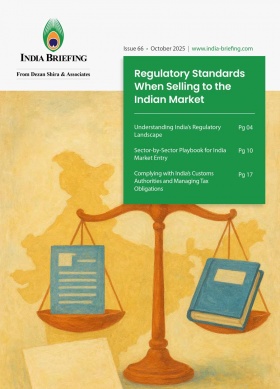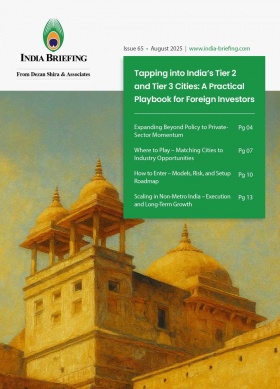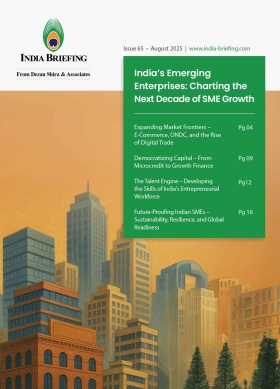India’s Per Capita Income Growth: 2024-25 Analysis
India’s growing income levels are influencing consumer preferences and driving a broader move toward discretionary spending. Current estimates indicate that India’s per capita income is around US$2,600 in FY 2024-25 and could approach US$5,000 by 2030; a level typically associated with increased demand for higher-quality and lifestyle-oriented products.
For businesses, this transition signals expanding prospects in premium product categories, branded offerings, and experience-driven services, as the market evolves into a more confident and aspiration-focused consumer economy.
India is experiencing steady income growth accompanied by evolving household consumption patterns. Market report estimates indicate that India’s per capita income has reached approximately US$2,600 in FY 2024-25 and may rise toward US$5,000 by 2030, a level often associated with a gradual shift from essential to discretionary spending.
According to a report from the Franklin Templeton titled, “Beyond Necessities: India’s Affluence-Driven Growth”, the share of upper-middle-income and affluent households in the country is projected to increase from 11.1 percent in 2010 to nearly 24 percent by 2035.
The report states that one in four Indian households is expected to possess meaningful discretionary spending power within the next decade. This shift is being reinforced by rising equity markets and increased household investment in gold, all of which are contributing to a stronger wealth effect and higher consumer confidence.
Key insights from Franklin Templeton’s report
Franklin Templeton’s latest report, issued on October 20, 2025, highlights a major shift in the country’s economic landscape. India is projected to become the world’s third-largest economy by 2030, overtaking Germany, as rising incomes are influencing consumer priorities and spending patterns.
|
*Projected Global GDP Ranking by 2030 |
||
|
Rank |
Country |
Projected GDP (in US$ trillion) |
|
1 |
United States (US) |
37 |
|
2 |
China |
36 |
|
3 |
India |
7 |
|
4 |
Germany |
6 |
|
5 |
Japan |
5 |
|
6 |
United Kingdom (UK) |
5 |
|
7 |
France |
4 |
|
8 |
Canada |
3 |
|
9 |
Italy |
3 |
|
10 |
Brazil |
3 |
Source: “Beyond Necessities: India’s Affluence-Driven Growth”- a Franklin Templeton report
*The GDP estimates are based on IMF and BofA Global Research estimates (May–August 2025 data).
Shift from necessity to aspiration-led consumption
As income levels rise, spending patterns are evolving in India. Franklin Templeton’s report notes that amongst the Indian population, discretionary expenditure, spending beyond basic needs, has grown steadily:
- ~15 percent of household spending in the 1950’s
- ~36 percent of household spending as of 2025
- Projected to exceed 43 percent of household spending by 2030
In the fast-moving consumer goods (FMCG) category, premium and branded categories are expanding faster than mass-market alternatives.
|
Category |
Premium subcategory |
10-year CAGR (%) |
Mass/normal subcategory |
10-year CAGR (%) |
|
Cleansing |
Liquid soap/body wash |
15 |
Bar soap |
6 |
|
Hair care |
Premium hair care |
16 |
Mass hair care |
7 |
|
Biscuits |
Filled biscuits |
9 |
Plain biscuits |
6 |
|
Tea |
Green tea |
25 |
Regular tea |
10 |
|
Sauces |
Mayonnaise |
26 |
Tomato ketchup |
13 |
|
Deodorants |
Premium deodorants |
18 |
Mass deodorants |
9 |
|
Laundry detergent |
Premium detergent |
26 |
Standard detergent |
7 |
|
Home care |
Air care products |
13 |
Dishwashing products |
9 |
|
Jewelry |
Titan jewelry segment |
18 |
Overall jewelry market |
9 |
|
Footwear |
Sports footwear |
13 |
Normal footwear |
8 |
Source: Euromonitor; CLSA; CY 2014–2024 data, October 2025
The consumption choice illustrates the local population’s increasing preference toward quality, identity, wellness, and brand experience; a further indication of a maturing, confidence-driven consumer economy.
ALSO READ: India’s Luxury Market Potential for Italian Brands
India’s broadening consumer base
The increase in India’s per capita income is progressively reflected in rural spending patterns. Economic expansion, better infrastructure, and wider digital connectivity have improved rural participation in the consumer economy, leading to better living standards outside urban centers.
Between 2012 and 2024, rural household expenditure grew at an average rate of 9.2 percent per year, slightly faster than urban growth of 8.5 percent. This has helped narrow the rural-urban consumption gap, from urban households spending 84 percent more than rural households in 2012 to about 70 percent in 2024. Monthly per capita expenditure in rural areas rose from INR 1,429 (US$16.13) in 2012 to INR 3,774 (US$42.60) in 2023, marking a shift from basic necessities to more discretionary and lifestyle-related purchases.
Notably, the share of food in rural budgets declined from about 60 percent to 47 percent, and in urban households from 48 percent to 40 percent, indicating broader spending on education, healthcare, consumer durables, and services. This trend aligns closely with rising per capita income nationwide, where higher earnings and declining population growth rates are enabling faster income gains per person.
Long-term trends in India’s per capita income
Per capita income provides a basic measure of economic well-being of a country. In India’s case, where the population is both large and diverse, it serves as a useful benchmark for evaluating the pace of growth relative to demographic expansion.
Data from the Ministry of Statistics and Program Implementation (MoSPI) shows that India’s per capita Net National Income (NNI) has consistently risen over the past decade, except during the COVID-19 pandemic.
|
Fiscal year |
Per capita NNI (current prices) |
Economic context |
|
2016-17 |
INR 104,880 (US$1,183.9) |
Stable growth before pandemic |
|
2019-20 |
INR 132,341 (US$1,493.9) |
Continued expansion |
|
2020-21 |
INR 127,244 (US$1,436,4) |
Pandemic contraction |
|
2023-24 |
INR 188,892 (US$2,132.3) |
Recovery and accelerated growth |
Source: National Accounts Statistics 2025 report, MoSPI
When adjusted for inflation (constant 2011-12 prices), real per capita income increased from INR 83,003 (US$936.98) in FY 2016-17 to INR 108,786 (US$1,228) in FY 2023-24. This indicates an actual improvement in purchasing power, although the recovery was uneven.
Population dynamics and income distribution
India’s population rose from approximately 1.3 billion in 2016-17 to around 1.4 billion in 2023-24. As per the United Nations Population Fund, India’s estimated population for 2025 is around 1.46 billion.
While the NSA 2025 report highlights that increase in economic output has outpaced population growth, gains are not evenly distributed.
- Urban centers and sectors such as technology, finance, pharmaceuticals, and formal manufacturing are experiencing rapid wage and income growth.
- Rural regions, informal employment, and agriculture-linked workers continue to see relatively slower income gains.
Therefore, while average per capita income is rising, differences in consumption capacity persist across income groups and regions. Policymakers and businesses must interpret per capita figures alongside these structural disparities.
Consumption and purchasing power: PFCE insights
Per capita Private Final Consumption Expenditure (PFCE) is another key indicator that reflects how much individuals actually spend. This helps assess living standards more accurately than income figures alone. India’s per capita PFCE increased from INR 70,258 (US$793.11) in 2016-17 to INR 129,967 (US$1,467) in 2023-24 at current prices, according to the NSA 2025 report.
At constant prices, PFCE reveals a more modest increase, indicating that rising prices have absorbed part of the gains in income.
This suggests that while incomes have increased, inflation has constrained real purchasing power, especially for essential categories such as food, fuel, and housing.
|
Difference Between Real Per Capita Income and Per Capita PFCE |
||
|
Concept |
Real per capita income |
Per capita PFCE |
|
Meaning |
The average income earned per person in the country, adjusted for inflation. |
The average amount each person spends on goods and services for personal use. |
|
Focus |
Income (earning capacity) |
Consumption (spending behavior) |
|
Basis |
Part of NNI |
Part of GDP expenditure (household + non-profit organizations’ spending/population) or H+NPO |
|
Indication |
How much money people can earn in real terms (purchasing power). |
How much people are actually spending to meet daily needs and lifestyle choices. |
|
Use in analysis |
Helps track standard of living and real income growth. |
Helps track consumer demand, lifestyle trends, and market size. |
Opportunities and growth projection
PFCE accounts for approximately 60 percent of India’s GDP, and rising income levels and expanding affluent households will play a decisive role in shaping future growth. Businesses across FMCG, retail, financial services, healthcare, electronics, hospitality, and lifestyle sectors are expected to come across new opportunities as premiumization accelerates.
However, sustaining this shift requires attention to:
- Productivity and skills enhancement
- Employment generation across high-value sectors
- Rural income diversification
- Managing inflation and ensuring financial inclusion
Other economic experts in India hold similar belief that the country’s per capita income is expected to double by the end of 2030. On October 3, 2025, India’s former bureaucrat N.K. Singh noted that slower population growth and higher nominal income expansion have accelerated per capita income growth, from around 1 percent annually in earlier decades (pre-1980) to nearly 6 percent annually in 2025.
Singh highlighted that the latest goods and services tax (GST) reforms will be central to this trajectory, improving ease of doing business, stimulating consumption, and reinforcing investor confidence.
To sustain and deepen income gains, he emphasized the need to enhance productivity, boost trade diversification, and increase net foreign direct investments (FDI) inflows from the current 1 percent of GDP to at least 3 percent.
Overall, the outlook suggests that India’s per capita income growth will increasingly depend on structural reforms and productivity-led expansion, alongside continued macroeconomic stability.
Conclusion
India’s rising per capita income reflects more than just economic expansion. It signals a transition toward an aspiration-driven consumer economy. As more households gain discretionary spending capacity, demand is expected to shift decisively toward premium goods, services, and lifestyle-based consumption. At the same time, ensuring that income growth is broad-based and equitable will be essential for translating economic gains into improved living standards for all.
Frequently asked questions (FAQs) on India’s rising per capita income and consumer trends
What is India’s current per capita income in FY 2024-25?
India’s per capita income in FY 2024-25 is estimated at around US$2,600, according to a Deloitte report and a Franklin Templeton report. This marks a steady increase from about US$1,183 in FY 2016-17, reflecting the country’s ongoing economic expansion.
How much is India’s per capita income expected to be by 2030?
India’s per capita income could approach US$5,000 by 2030, as projected by multiple market reports, including Franklin Templeton’s Beyond Necessities: India’s Affluence-Driven Growth. This level is typically associated with a structural shift toward higher-quality and lifestyle-driven consumption.
How is India’s income growth influencing consumer behavior?
Rising income levels are transforming India into an aspiration-driven consumer economy. Spending is increasingly directed toward premium goods, branded products, and experience-based services. Discretionary spending now accounts for about 36 percent of household expenditure and is projected to exceed 43 percent by 2030.
Which product categories are seeing the fastest premium growth in India?
Premium subcategories in FMCG and lifestyle products are expanding faster than mass-market alternatives. Examples include:
- Green tea (+25% CAGR vs. 10% for regular tea)
- Premium detergents (+26% vs. 7%)
- Mayonnaise (+26% vs. 13% for tomato ketchup)
- Liquid soaps and body washes (+15% vs. 6% for bar soap)
What does the shift from necessity to discretionary spending mean for businesses?
The transition indicates new opportunities in premiumization. Companies can tap demand in segments such as personal care, packaged foods, fashion, electronics, hospitality, wellness, and home improvement. Consumers are prioritizing quality, identity, and brand experience over price alone.
How are rural consumers contributing to India’s market expansion?
Rural household expenditure grew at 9.2 percent annually between 2012 and 2024, outpacing urban growth of 8.5 percent. Improved infrastructure and digital access are narrowing the rural-urban consumption gap, with rural spending increasingly shifting toward education, healthcare, and consumer durables.
How can companies assess market entry opportunities in India’s consumer economy?
Rising income levels and an expanding middle class signal long-term consumption-led growth. For foreign investors, India offers a large, youthful, and increasingly affluent market with opportunities in both urban and emerging rural segments.
Businesses planning to enter India can benefit from custom market research, location analysis, and regulatory guidance to target growth segments effectively.
(US$1 = INR 88.58)
About Us
India Briefing is one of five regional publications under the Asia Briefing brand. It is supported by Dezan Shira & Associates, a pan-Asia, multi-disciplinary professional services firm that assists foreign investors throughout Asia, including through offices in Delhi, Mumbai, and Bengaluru in India. Dezan Shira & Associates also maintains offices or has alliance partners assisting foreign investors in China, Hong Kong SAR, Vietnam, Indonesia, Singapore, Malaysia, Mongolia, Dubai (UAE), Japan, South Korea, Nepal, The Philippines, Sri Lanka, Thailand, Italy, Germany, Bangladesh, Australia, United States, and United Kingdom and Ireland.
For a complimentary subscription to India Briefing’s content products, please click here. For support with establishing a business in India or for assistance in analyzing and entering markets, please contact the firm at india@dezshira.com or visit our website at www.dezshira.com.
- Previous Article Public Holidays in India 2026 and Key HR Considerations
- Next Article How Global Companies Leverage Offshore Accounting for Scale & Speed








